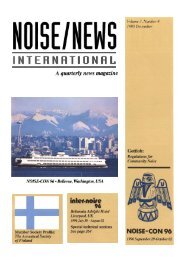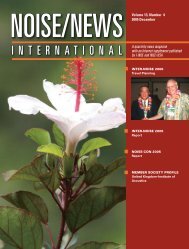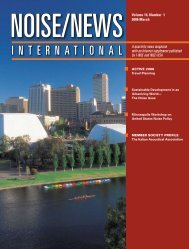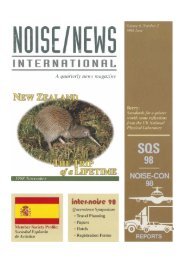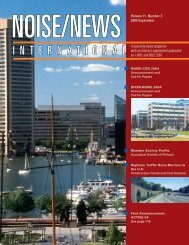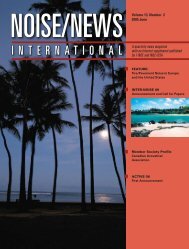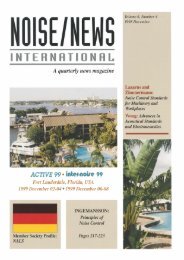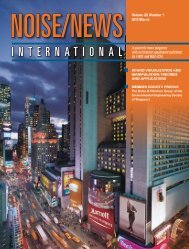Volume 15, Number 4, December, 2007 - Noise News International
Volume 15, Number 4, December, 2007 - Noise News International
Volume 15, Number 4, December, 2007 - Noise News International
- No tags were found...
Create successful ePaper yourself
Turn your PDF publications into a flip-book with our unique Google optimized e-Paper software.
attention from local, regional andnational decision makers and politicians.• Attention from national politicians is aprerequisite for bringing the subject tothe attention of international bodies.Building noisepolicy in KoreaHee Joon EunKorea Research Institute ofStandards and ScienceBackgroundKorea is a highly “condensed” country interms of both human population and socialinfrastructures. There are nearly 49 millionpeople in a land the size of Indiana wheremountains and hills cover 75 percent of theland. Koreans were aware of the potentialenvironmental impact of such natural andsocial constraints even during its relativelyearly development stage in the 1970s. In1980, Korea began an earnest effort forenvironmental protection and preservationby establishing the EnvironmentalProtection Agency as a vice-ministeriallevel government body. Although withthe developmental momentum, theenvironment had been deterioratinguntil the mid-1990s, Korea’s communityenvironment is now improving.<strong>Noise</strong> policy in Korea may be classifiedas either environmental policy orimplementation policy.Environmental Policy directs theadministrative action and defines theenvironmental goal of Korea. TheImplementation Policy stipulates the rulesand strategy for the realization of theEnvironmental Policy goals. The policiesare defined by the following laws.• The Basic Law for EnvironmentalPolicy (enacted by the Parliament)defines Korea’s Environmental Policyfor factors such as air, water, andnoise, and provides the legal basis forthe Implementation Policy to enablethe realization of the EnvironmentalPolicy goals.• The Regulatory Law for <strong>Noise</strong> andVibration (enacted by the Parliament)derives its legal authenticity from theBasic Law for Environmental Policyand covers areas of noise and vibrationproblems. This law stipulates policygoals for each area, as well as thegeneral plan to be undertaken by thecentral and local governments for therealization of this policy.• The Implementation Order for theRegulatory Law (Presidential Order)is not a law, but a Presidential Orderwhich stipulates detailed actions to beundertaken by the central and localgovernments in order to implement theactions stipulated by the RegulatoryLaw.• The Implementation Rules for theRegulatory Law (established by theMinistry) is not a law, but a MinisterialOrder which stipulates further detailedactions to be deemed necessary duringthe course of the execution of the Law.Evolution of <strong>Noise</strong> Policyin accordance with SocialDemandIn chronological order, the EnvironmentalPolicy for <strong>Noise</strong> was the first declared bythe Basic Law for Environment Policy,setting a framework for all other noisepolicies. The Law stipulates the goalof the Policy numerically in the form ofEnvironmental Standards for <strong>Noise</strong> asfollows:AreaClassificationGeneralAreaRoadsideAreaZoneClassificationZone AZone BZone CZone DZone A and BZone CZone DStandardsDay(06 - 22)50556570657075Table 1. Environmental Standards for<strong>Noise</strong> [Unit = L Aeq]Night(22 - 06)40455565556070The framework for the EnvironmentalPolicy comes from an ISORecommendation, but the details arebased on data obtained during a two-yearnationwide noise survey between 1981 and1982. The definitions of various areas andzones are given in detail in the Law—ZoneA includes exclusive dwelling sites, 50m range of schools or hospitals, andZone B includes dwelling sites with lightcommercial activities. The <strong>Noise</strong> Standardsare applied to road traffic noise only.For the purpose of supporting and realizingthe Environmental Policy, a series ofImplementation Policies were developed.Table 2 gives a brief history.In Table 2, each policy in the first columnis accompanied by a reference in thefourth column. These references are thenumerical targets for which each of thepolicies is applied and are specified in theLaw. These references may be classifiedinto the following three groups:• Environmental Standards are notregulatory limits applied to a specificindividual, but policy targets by whichthe central and local governmentsestablish the legal and administrativeframework to protect and preserve theenvironment. At the moment, there arethree Environmental Standards in Koreafor air, water, and noise respectively.These Standards also serve as a referenceguide for any technical activities relatedto environmental protection.• <strong>Noise</strong> Limits (Allowed EmissionLimit and Regulatory Limit). Unlikethe Environmental Standards, theLimits must be observed. TheAllowed Emission Limit is appliedat the boundary of factories or at aspecified location from vehicles. Thisis a source-control plan. The other,the Regulatory Limit, is applied at theboundary of the affected area. ThisLimit is intended to provide offenderswith some flexibility when noise isinevitable, such as in construction.The Allowed Emission Limit is morestringent than the Regulatory Limit. In140 www.inceusa.org • www.noisenewsinternational.net • www.i-ince.org <strong>2007</strong> <strong>December</strong>



